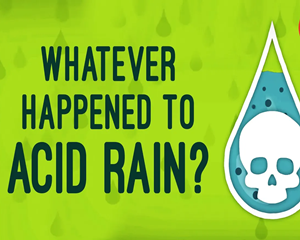In 1963, scientists studying Hubbard Brook Experimental Forest in New Hampshire made a shocking discovery.
1963年,在汉普郡哈伯德布鲁克实验林学习的科学家们,有了一个惊人的发现。
Their most recent rainfall samples were nearly 100 times more acidic than usual.
他们最近雨水样本的酸度几乎是往常酸度的100倍。
At these levels, additional downpours of acid rain would destroy the region's marine and arboreal ecosystems in a matter of decades.
在这样的酸度水平下,更多的雨量将在几十年内摧毁地区的海洋和林木生态系统。
Urgently sharing their findings with fellow researchers, they were determined to answer two questions:
迫切地想与其他研究员分享他们的这个发现,他们决定回答两个问题:
what was causing this deadly rainfall? And what could be done to stop it?
是什么使雨水变得致命?,我们能做什么去阻止它?
Rain is never just composed of water.
雨水不止是由水组成。
Chemicals and particulates in the atmosphere can be found in every drop, and some compounds -- like carbon dioxide -- make even regular rainfall slightly acidic.
每滴雨水中都发现含有大气中的化学物质和微粒,某些化合物,像二氧化碳,使正常的雨水有些微酸性。
But this pales in comparison to the powerful acids produced when water interacts with oxides of nitrogen or sulfur dioxide.
但和水与氮的氧化物,或与二氧化硫形成的强酸时相比,这酸度就显得相形见绌了。
On the pH scale which measures acidity, each whole number is 10 times more acidic than the one above it.
在用pH尺度衡量酸度时,每个整数比后一个整数酸10倍。
And where normal rain has a pH of roughly 5.4, rain that's interacted with these gases can rank as low as 3.7.
正常雨水的pH大约是5.4,雨水若是与这些气体作用,将会使此等级降至3.7。
Oxides of nitrogen and sulfur dioxide can appear naturally as a short-lived byproduct of volcanic eruptions or lightning strikes.
含氮氧化物和二氧化硫能在火山爆发和雷击时,作为产生的天然副产物短暂在世停留。
But power plants, refineries, and vehicles that use fossil fuels consistently pump large quantities into the air.
但是发电厂,提炼厂和使用化石燃料的交通工具,持续地将这些氧化物泵到空气中。
These dangerous gases travel with the wind spreading hundreds of kilometers from the pollution's source.
这些有害气体随风从源头地流动几百千米扩散到各地。
Acting like roaming clouds of destruction, their presence dramatically increases the acidity of local precipitation, creating acid rain, acid snow, and acid fog.
就像在漫游的有毁灭性的风,它们的到来使当地雨水的酸度有了显著的升高,就产生了酸雨、酸性雪、酸雾。
These all acidify lakes and streams, kill crops and forests, and damage soil to inhibit future growth.
这些酸性湖泊和溪流毁掉了作物和林木,损害土壤,抑制了植物以后的生长。
Over time, acid rain can even corrode human structures made of stone or metal.
随着时间的推移,酸雨也会腐蚀人类用石头和金属所造的建筑。
By the 1970s, scientists in North America and Europe classified acid rain as a major environmental threat.
在20世纪70年代,北美和欧洲的科学家将酸雨视为排在首位的环境威胁。
But despite clear evidence tying the problem to air pollution, companies denied responsibility and cast doubt on the research.
但是即使空气污染和有害气体的排放有明显的联系,企业也否认他们应该承担责任,并对此项调查提出了质疑。

In the United States, corporations lobbied against regulating pollution, and convinced politicians that such policies would raise energy costs and threaten jobs.
在美国,企业游说反对控制污染,说服政客倘若实行这种政策,将会耗费更多的能源资金且威胁到就业。
These obstacles led the government to delay changes, and mandate further research into the issue.
这些障碍让政府推迟了改变,下令让此项目做进一步的研究。
But after a decade of mounting concern, Congress finally took action.
但在十年后关注度越来越高以后,国会终于采取了行动。
Since the bulk of sulfur dioxide emissions came from power plants, the government set a limit on the total amount of it the electric power sector could emit each year.
因为大部分二氧化硫是从发电厂排放出来的,政府限制其电力部门每年容许的总排量。
Then, they divided the permitted emissions into a fixed number of "allowances" distributed to each power plant.
然后,他们将允许的排放量分成固定数量的配额,分配给每个发电厂。
A plant could then choose to emit as much sulfur dioxide as they were allowed, or reduce their emissions and sell their unused allowances to other power plants.
工厂可以在允许范围内,选择排放尽可能多的二氧化硫或者缩小排放量,并把他们未使用的配额卖给其他发电厂。
This system, known as "cap and trade," offered power plants the economic flexibility to keep costs low while strictly limiting pollution.
这个体制名为“总量管制与交易”,保障了当严格的污染限制条令下发时,发电厂保持低成本的灵活经济性。
Many critics called these allowances licenses to pollute, or said the government was selling clean air.
许多批评人士称这些为免税额污染许可证,或者说政府卖干净的空气。
But since the cap was set to lower five years into the program, it forced every utility company to reduce emissions in the long term.
但由于上限被设定为五年后还要降得更低,它迫使所有公用事业公司长期削减排放。
Some plants added desulfurizing scrubbers to their smokestacks, or switched to low-sulfur coal and natural gas.
一些工厂在他们的烟囱中增加了脱硫机,或者改用低硫煤和天然气。
Oxides of nitrogen emissions were also reduced with relatively low-cost technologies.
用相对低成本的技术,也减少了氮氧化物的排放。
These advances allowed the power sector to grow while the cap kept pollution under control.
这些进步使电力部门得以发展,而上限使污染得到控制。
By 1985, Canada and the European Union adopted their own solutions, and international treaties began circulating to reduce air pollution worldwide.
到1985年,加拿大和欧盟采用了各自的解决方案,为了减少全球大气污染,国际条约开始相继使用。
Today, this science-driven economic policy has largely eliminated acid rain across the United States and Canada.
如今,这种以科学为导向的经济政策已在很大程度上消除了整个美国和加拿大的酸雨。
And while many ecosystems still need time to recover, scientists have sped up the restoration of other areas by reintroducing essential organisms killed off by acid rain.
尽管许多生态系统仍然需要时间来恢复,但科学家们通过引入被酸雨杀死的必要生物体,来加快修复其他地区的进程。
Some countries, like Russia, India, and China still rely heavily on high-sulfur coal and continue to struggle with the environmental consequences.
有些国家,像俄罗斯、印度和中国,仍然极度依赖高硫煤,将继续与环境带来的后果作斗争。
However, acid rain's relatively quick journey from major threat to minor issue is rightly celebrated as a victory for policies that protect the environment.
然而,酸雨相对迅速地从重大威胁变成了次要问题是环境保护政策的胜利。
Cap and trade can't solve every environmental problem.
“总量管制与交易”不能解决每个环境问题。
But by using scientific consensus to guide policy, adopting efficient technology, and being unafraid to impose reasonable costs for pollution,
但通过运用科学共识指导政策,运用有效的科技手段,不惧因为污染施加的合理成本,
countries can stop a growing storm of destruction before it's too late.
国家们还能在不算晚的时间点,制止一场正在壮大的毁灭性风暴。













